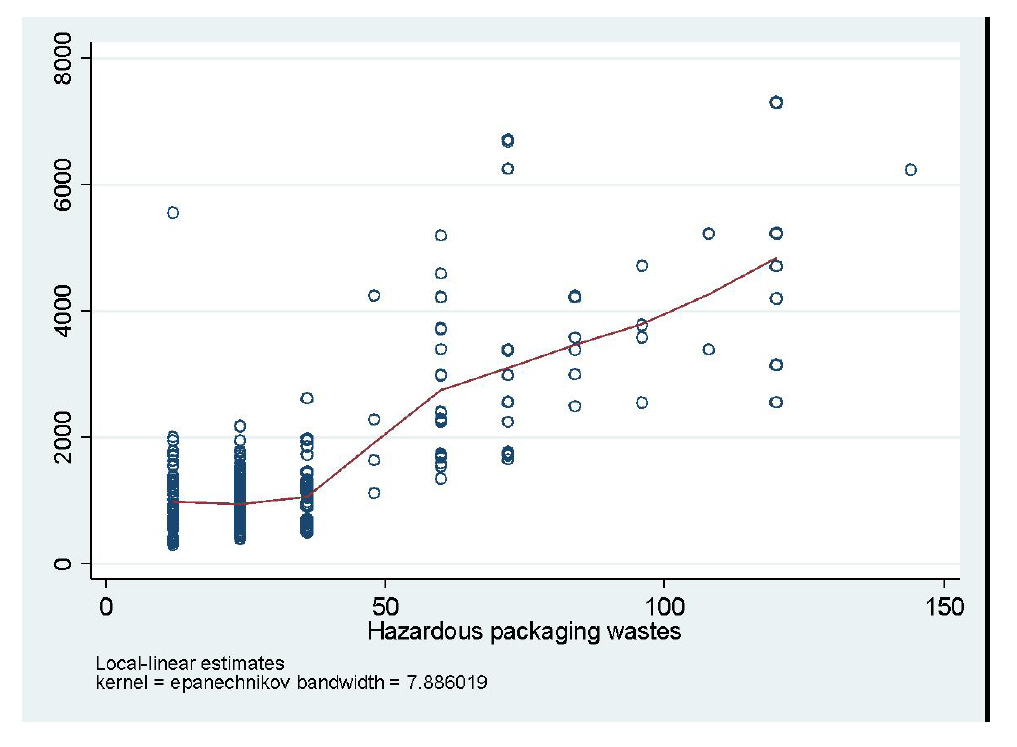An optimal deposit-refund system for mitigating hazardous packaging waste in Thailand's agricultural sector
Main Article Content
Abstract
This study utilized a Deposit-Refund System (DRS) with an optimal rate of deposit in order to increase the return rate of hazardous chemical packaging waste back into the system. Both survey and time series data were used to examine the willingness to pay (WTP) of Thai farmers and the marginal social cost of waste disposal (MSC) so that they would be used as an appropriate deposit rate. The findings indicate that using MSC at 0.30 USD/bottle as deposit rate would induce a higher return rate than using WTP at 0.15 USD/bottle. The distance between farmers’ homes and hazardous chemical shops can also negatively affect the return rate. Thus, to reduce hazardous packaging waste in Thai agriculture, the government needs to impose a deposit rate at 0.30 USD/bottle (MSC) and strategically increase the number of returning points in order to boost the return rate for hazardous packaging waste.
Article Details

This work is licensed under a Creative Commons Attribution-NonCommercial-NoDerivatives 4.0 International License.
References
Pollution Control Department, Thailand Pollution situation in 2014. http://www.pcd.go.th/download/waste.cfm, 2015(accessed 20 October 2017).
Pollution Control Department, Situation, Problem and Policy Guideline for Waste Management in Thailand. http://www.pcd.go.th/download/waste.cfm, 2013 (accessed 20 October2017).
T. Tietenberg, Environmental and natural resource economics, Addison-Wesley, New York, 2000.
E. W. Oates, J. W. Baumol, The instruments for environment policy, National Bureau of Economic Research (1975) 95 – 145.
OECD, Applying economic instruments to packaging waste: practical issue for product charge and deposit-refund system, OECD Environment monographs 82 (1993) 1 – 68.
D. Hogg, C. Sherrington, T. Vergunst, A comparative study on economic instruments promoting waste prevention, Eunomia Research and Consulting Ltd. http://www.eunomia.co.uk/reports-tools/a-comparative-study-on-economicinstruments-promoting-waste-prevention-2/, 2011 (accessed 17 Jan 2017).
D. Fullerton, W. Wu, Policies for green design, Journal of Environmental Economics and Management 36 (1998) 131 – 148.
K. Siritorn, C. K. Permpoonwiwat, An optimal solid waste collection fee based on area characteristics using hedonic pricing approach, International Journal of Environment and Waste Management 24(4) (2019) 451 – 465.
D. Fullerton, A.Wolverton, The case for a two-part instrument: presumptive tax and environmental subsidy, NBER Working Papers 5993. http://www.nber.org/papers/w5993.pdf, 1997 (accessed 20 October 2017)
D. Fullerton, A. Wolverton, Two generalizations of a deposit refund system, American Economic Review 90(2) (2000) 238 – 242.
K. Palmer, M.Walls, Optimal policies for solid waste disposal taxes, subsidies, and standards, Journal of Public Economics 65 (1997) 193 – 205.
K. Palmer, H. Sigman, The cost of reducing municipal solid waste, Journal of Environmental Economics and Management 33 (1997) 128 – 150.
M.Walls, Deposit-refund systems in practice and theory, RRF Discussion Paper. https://www.rff.org/publications/workingpapers/deposit-refund-systems-in-practice-and-theory/, 2011 (accessed 20 Oct 2017).
F. Oosterhuis, E. Papyrakis, B. Boteler, Economic instruments and marine litter control, Ocean & Coastal Management 102
(2014) 47 – 54.
D. Fullerton, A. Wolverton, The two-part instrument in a second-best world, Journal of Public Economics 89 (2005)
– 1975.
M. B. Kursah, A. Baabereyir, Willingness to pay for sachet water plastic waste management through deposit-refund system,
International Journal of Environment and Waste Management 23(2) (2019) 141 – 155.
D. Lavee, A cost-benefit analysis of a deposit-refund program for beverage containers in Israel,Waste Management 30 (2010) 338 – 345.
D. Numata, Economic analysis of deposit-refund systems with measures for mitigating negative impacts on suppliers, Resources, Conservation and Recycling 53 (2009) 199 – 207.
R. B. Belzer, Economic incentives for hazardous waste management: Deposit-refund systems and used lubricating oil, Dissertation, Harvard University, 1989.
Pollution Control Department, Thailand pollution report in 2018. http://www.pcd.go.th/file/ThailandPollutionReport2018Thai.pdf, 2018 (accessed 4 August 2020).
R. C. Mitchell, R. T. Carson,Using surveys to value public goods: The contingent valuation method, resources for the future,
Washington, D.C., 1989.
N. Zainudin, N. Nordin, H. B. Shilpi, Survey designing for contingent valuation studies, Proceeding of the 2nd International
Conference on Economics & Banking 2016, pp. 381 – 387.
Songkhla Municipal Oce, Songkhla municipality report 2016. http://www.songkhlacity.go.th, 2016 (accessed 15 Mar 2017).
D. Numata, Optimal design of deposit-refund systems considering allocation of unredeemed deposits, Environmental Economics and Policy Studies 13 (2011) 303 – 321.
D. N. Gujarati, Basic econometrics, McGraw Hill, New York, 2003.
J. Wooldridge, Econometric analysis of cross section an panel data, The MIT press, London, 2002.
R. B. D’Agostino, A. Belanger, B. Ralph, Jr. R. B. D’Agostino, A suggestion for using powerful and informative tests of normality, The American Statistician 44 (1990) 316 – 321.
P. Royston, Approximating the Shapiro-Wilk W-test for nonnormality, Statistics and Computing 2 (1992) 117 – 119.
O. A. Elamin, Nonparametric kernel estimation methods for discrete conditional functions in econometrics, Dissertation,
The University of Manchester, 2013
E. A. Nadaraya, On estimating regression, Theory of Probability and Its Applications 9(1) (1964) 141 – 142.
G. S. Watson, Smooth regression analysis, Sanikhya Series A 26(15) (1964) 175 – 184.
A. Ullah, H. D. Vinod, Nonparametric kernel estimation of econometric parameters, Journal of Quantitative Economics 4(1) (1988) 81 – 87.
A. Ullah, Nonparametric estimation and hypothesis testing in econometric models, Empirical Economics 13 (1988) 223 – 249.
D. J. Henderson, A. C. Souto, An introduction to nonparametric regression for labor economists, Discussion paper series, IZA - Institute of Labor Economics, German, 2018.
K. Siritorn, C. K. Permpoonwiwat, Effects of area characteristics and municipal waste collection fees on household waste generation, Journal of Material Cycles and Waste Management 22(1) (2019) 89 – 96.


